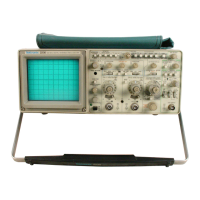Operating Considerations-2230 Operators
components at or near the circuit's resonant frequency.
Oscillations (ringing) can then appear
on
the oscilloscope
waveform display
and
distort the true signal waveshape.
Always keep both the ground lead
and
the probe signal-
input connections
as
short
as
possible
to
maintain the
best waveform fidelity.
Misadjustment of probe compensation
is
a common
source of measurement error.
Due
to variations
in
oscillo-
scope input characteristics, probe compensation should
be
checked
and
adjusted, if necessary, whenever the probe is
moved from one oscilloscope to another or between chan-
nels. See the probe compensation procedure
in
"Operator's Check
and
Adjustments", or consult the
instructions supplied with the probe.
Coaxial Cables
Cables may also
be
used to connect signals to the ver-
tical input connectors, but they may have considerable
effect
on
the accuracy of a displayed waveform. To main-
tain the original frequency characteristics of
an
applied sig-
nal, only high-quality, low-loss coaxial cables should
be
used. Coaxial cables should
be
terminated at both ends
in
their characteristic impedance. If this
is
not possible,
use
suitable impedance-matching devices.
INPUT-COUPLING
CAPACITOR PRECHARGING
When the Input Coupling switch
is
set to the
GND
posi-
tion, the input signal is connected to ground through the
input-coupling capacitor
and
a high resistance value. This
series combination forms a precharging circuit that allows
the input-coupling capacitor to charge to the average
de
voltage level of the signal applied to the input connector.
Thus, any large voltage transients that may accidentally
be
generated are not applied to the vertical amplifier's input
when the input coupling is switched from
GND
to
AC. The
precharging network also provides a measure of protection
to
the external circuitry by reducing the current level that
is drawn from the external circuitry while the input-
coupling capacitor is charging.
4-2
If AC input coupling
is
in
use, the following procedure
should
be
followed whenever the probe tip
is
connected
to
a signal source having a different
de
level than that previ-
ously applied. This procedure becomes especially useful if
the de-level difference
is
more than ten times the
VOL TS/DIV switch setting.
1.
Set the AC-GND-DC (input coupling) switch
to
GND
before connecting the probe tip to a signal source.
2.
Touch the probe tip to the oscilloscope
GND
con-
nector.
3.
Wait several seconds for the input-coupling capaci-
tor to discharge.
4.
Connect the probe tip to the signal source.
5.
Wait several seconds for the input-coupling capaci-
tor to charge to the
de
level of the signal source.
6.
Set the AC-GND-DC switch to AC. A signal with a
large
de
component
can
now
be
vertically positioned within
the graticule area,
and
the
ac
component of the signal can
be
measured
in
the normal manner.

